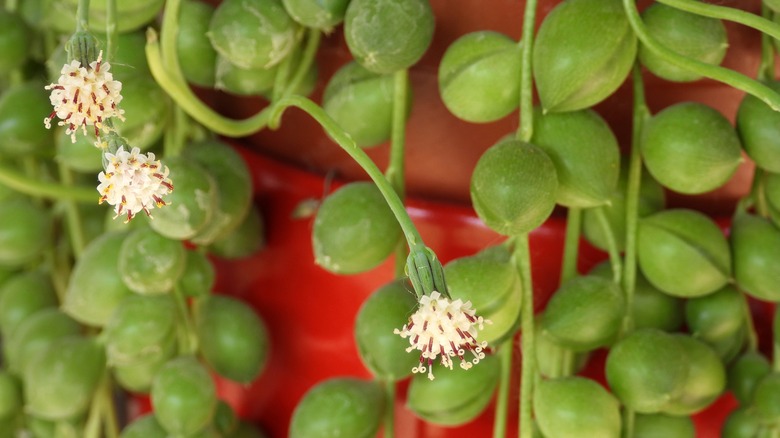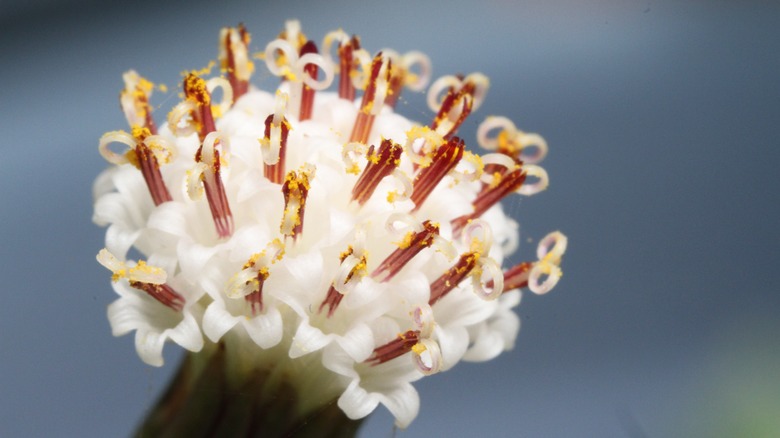This Drought-Tolerant Houseplant Will Fill Your Home With Fresh Cinnamon Smells
String of Pearls (Senecio rowleyanus) is a popular houseplant thanks to its lovely cascading habit, drought-tolerance, and low-maintenance requirements. This alluring plant also has a hidden talent that can add another sensory dimension to your interiors. The blooms on string of pearls look just like tiny white pom poms with their long red stamens protruding outwards above the small white petals. When in bloom, the tiny white flowers release a delicious cinnamon scent that can fill your home. This plant will bloom in summer when given the right conditions and the flowers can last for up to one month, but many succulents don't bloom easily when kept indoors because they need just the right conditions before they'll delight you with their flowers.
When handling your string of pearls, remember that this plant is toxic to humans and pets, and contains a sap that can cause irritation to your skin along with digestive issues when ingested. So it's especially important to keep small children and pets away. If you're going to successfully grow a string of pearls plant, you also want to make sure you wash your hands after touching the plant or wear gloves to protect your skin.
How to encourage your string of pearls to flower
If you want to enjoy the delicious cinnamon aroma that a flowering string of pearls will exude, you need to give the plant the perfect environment during winter. If you get this just right, the plant should reward you with its lovely scented flowers.
The first trick is to keep your string of pearls fairly dry over the winter months. As you probably know, succulents are house plants that you barely need to water. It's important to let the soil dry out completely before giving the plant any water. Over winter, it's common to only water succulents like string of pearls once a month or less. If you want to make sure that you're not overwatering your plant, keep a close eye on it and wait for the tiny green leaves to shrivel just a little before giving the plant any water.
The other trick to getting your string of pearls to bloom is to allow it to rest over winter by keeping it in a fairly cool spot in your home. The ideal temperature is between 55 to 65 degrees Fahrenheit. This is one way to mimic the plant's natural environment, which is the Eastern Cape of South Africa. This region has an average temperature of between 44 to 68 degrees Fahrenheit in winter with low rainfall. So when you provide your plant with similar conditions in your home, you should be able to encourage it to flower.
Daylight plays an important role, too
The string of pearls is a long-day succulent because it blooms in summer. So another way to encourage your plant to bloom is to give your plant lots of bright indirect light through spring and summer. Consider moving your plant close to an east-facing window so that it gets plenty of morning light. It's generally advised not to leave string of pearls in direct daylight for too long as too much can damage your plant. If you don't have any east-facing windows and you're really keen to encourage your plant to bloom, you could consider using a grow light and turning this on for up to 14 hours a day during its active growing season.
According to Wisconsin Horticulture Extension, you could even move your string of pearls outdoors during spring and summer, as long as you have a spot that is somewhat shaded and protected from rainfall, and you take steps to acclimatize the plant to avoid damage from the sun.
Even though succulents are low-maintenance plants that you don't have to fertilize, you could give your string of pearls a liquid fertilizer to move things along. Apply this in early spring and repeat the application every two weeks during the plant's active growing season.


